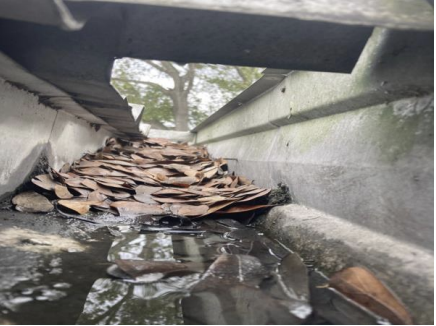Preparation is key when it comes to protecting your roof from the heavy rains that come with the rainy season in Florida. Here are a few ways to prepare your roof for the rainy season.
Inspect the Roof
A thorough roof inspection should be performed before the rainy season begins. Check for any signs of damage, such as cracked or missing shingles, and address them immediately.
In addition to the above items, it’s also important to check for any signs of algae or moss growth on the roof. Algae and moss can hold moisture and cause damage to the shingles, leading to leaks. If you notice any growth, it’s best to have a professional like MGC Roofing inspect or clean the roof. If you need to get on the roof, make sure to take necessary safety precautions and use a sturdy ladder.
Clear Gutters
Cleaning out gutters regularly is important for ensuring proper water flow. During the rainy season, clogged gutters can lead to water damage and leaks.
Gutters play a crucial role in directing water away from your roof and the foundation of your building. When gutters become clogged with debris such as leaves, twigs, and dirt, the flow of water is disrupted. This can cause water to overflow, leading to water damage on the roof and inside the building. Additionally, if water is allowed to sit in clogged gutters, it can cause corrosion, rust, and damage to the gutter system. To prevent these issues, it’s important to clean out gutters regularly and especially before the rainy season. This ensures that the gutters are able to function properly and direct water away from your building, protecting your roof and the structure from potential damage.
Repair Damaged Shingles
Damaged shingles on the roof can be a major problem during the rainy season. When shingles are damaged, they can no longer effectively protect the roof from the elements, which can result in water penetrating the roof and causing leaks. These leaks can result in water damage to the structure of the building, including the walls and ceilings, as well as the contents inside, such as furniture, electronics, and other equipment. Furthermore, water damage can lead to mold growth, which can cause serious health problems for building occupants. To avoid these problems, it’s crucial to replace damaged shingles as soon as they are discovered. This will ensure that the roof continues to provide adequate protection against rain and other weather-related issues.
Check the Flashing
Flashing is the metal material used to seal the joints between roof sections and other building elements. Check that the flashing is secure and free of cracks or rust. Properly installed flashing helps to prevent water from seeping into the building through the roof. Any damage or wear to the flashing, such as cracks or rust, can compromise its ability to prevent water from infiltrating the building, causing leaks and water damage to the interior of the building. Additionally, if the flashing is not securely in place, it could allow water to penetrate the roof, leading to even more severe damage over time. To avoid this, it is essential to regularly inspect the flashing and repair any damage promptly, ensuring that it remains in good condition and is able to protect the building from water damage during the rainy season.
Trim Nearby Trees
Trees near your roof can cause damage during heavy winds and rain. Trim branches that hang over your roof to prevent them from causing damage. Having trees near your roof can create several potential problems, especially during the rainy season. When strong winds and heavy rain hit, overhanging branches can break off and cause significant damage to your roof, potentially leading to leaks, punctures, or even cave-ins. To avoid this, it’s important to inspect the trees close to your roof and trim any branches that hang over it. This will reduce the risk of damage to your roof and protect your property from potential water damage and other related issues. Additionally, removing overhanging branches can also reduce the likelihood of debris clogging up your gutters, helping to keep the water flowing smoothly. By taking these steps, you can help ensure that your roof is prepared for the rainy season and protect your property from potential damage.
Remove Roof Debris
Debris on your roof can hold moisture, leading to the growth of mold and mildew. Regularly remove debris, such as leaves and twigs, from your roof. Having debris on your roof not only impacts the appearance of your building, but it can also cause serious harm to the roof and the structure of your building. Leaves, twigs, and other debris can hold moisture, creating the perfect environment for mold and mildew to grow. This not only detracts from the appearance of your building but also weakens the roof structure, making it more vulnerable to leaks and other types of damage. To prevent this, it is essential to regularly remove any debris from your roof and maintain a clean, dry surface. This will not only help your roof to look its best, but it will also help extend its lifespan and keep your building protected from water damage.
Check Insurance
Finally, make sure your homeowner/business insurance policy is up to date and covers damage from heavy rains. Being prepared with the right insurance coverage can give you peace of mind during the rainy season. (Don’t forget to take before and after pictures to document the condition of your roof!)
In conclusion, preparing your roof for the rainy season requires careful attention to detail and proactive measures. Whether you choose to perform a roof inspection yourself or hire a professional, the key is to identify and address any issues before they become major problems. With proper preparation, you can keep your roof in top condition and protect your home or business from water damage during the rainy season.

